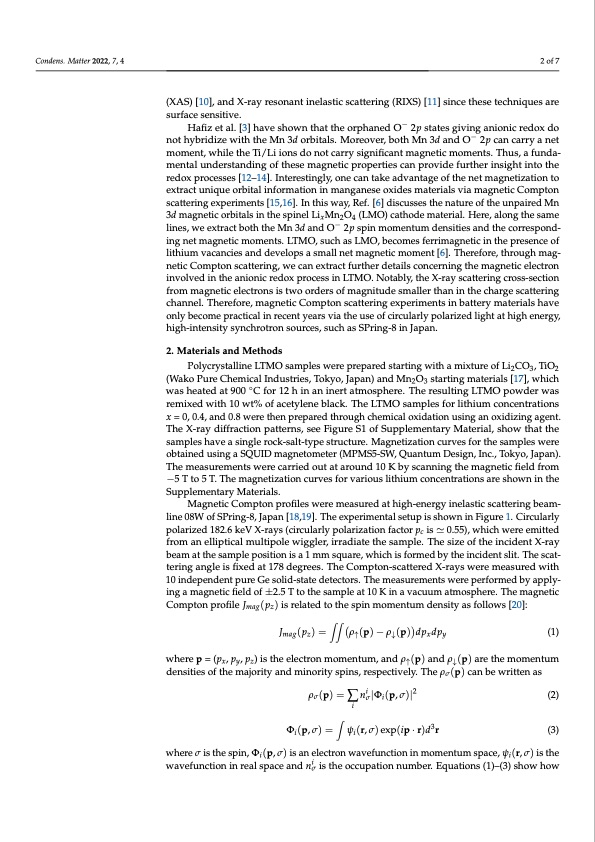
PDF Publication Title:
Text from PDF Page: 002
Condens. Matter 2022, 7, 4 2 of 7 (XAS) [10], and X-ray resonant inelastic scattering (RIXS) [11] since these techniques are surface sensitive. Hafiz et al. [3] have shown that the orphaned O− 2p states giving anionic redox do not hybridize with the Mn 3d orbitals. Moreover, both Mn 3d and O− 2p can carry a net moment, while the Ti/Li ions do not carry significant magnetic moments. Thus, a funda- mental understanding of these magnetic properties can provide further insight into the redox processes [12–14]. Interestingly, one can take advantage of the net magnetization to extract unique orbital information in manganese oxides materials via magnetic Compton scattering experiments [15,16]. In this way, Ref. [6] discusses the nature of the unpaired Mn 3d magnetic orbitals in the spinel LixMn2O4 (LMO) cathode material. Here, along the same lines, we extract both the Mn 3d and O− 2p spin momentum densities and the correspond- ing net magnetic moments. LTMO, such as LMO, becomes ferrimagnetic in the presence of lithium vacancies and develops a small net magnetic moment [6]. Therefore, through mag- netic Compton scattering, we can extract further details concerning the magnetic electron involved in the anionic redox process in LTMO. Notably, the X-ray scattering cross-section from magnetic electrons is two orders of magnitude smaller than in the charge scattering channel. Therefore, magnetic Compton scattering experiments in battery materials have only become practical in recent years via the use of circularly polarized light at high energy, high-intensity synchrotron sources, such as SPring-8 in Japan. 2. Materials and Methods Polycrystalline LTMO samples were prepared starting with a mixture of Li2CO3, TiO2 (Wako Pure Chemical Industries, Tokyo, Japan) and Mn2O3 starting materials [17], which was heated at 900 ◦C for 12 h in an inert atmosphere. The resulting LTMO powder was remixed with 10 wt% of acetylene black. The LTMO samples for lithium concentrations x = 0, 0.4, and 0.8 were then prepared through chemical oxidation using an oxidizing agent. The X-ray diffraction patterns, see Figure S1 of Supplementary Material, show that the samples have a single rock-salt-type structure. Magnetization curves for the samples were obtained using a SQUID magnetometer (MPMS5-SW, Quantum Design, Inc., Tokyo, Japan). The measurements were carried out at around 10 K by scanning the magnetic field from −5 T to 5 T. The magnetization curves for various lithium concentrations are shown in the Supplementary Materials. Magnetic Compton profiles were measured at high-energy inelastic scattering beam- line 08W of SPring-8, Japan [18,19]. The experimental setup is shown in Figure 1. Circularly polarized 182.6 keV X-rays (circularly polarization factor pc is ≃ 0.55), which were emitted from an elliptical multipole wiggler, irradiate the sample. The size of the incident X-ray beam at the sample position is a 1 mm square, which is formed by the incident slit. The scat- tering angle is fixed at 178 degrees. The Compton-scattered X-rays were measured with 10 independent pure Ge solid-state detectors. The measurements were performed by apply- ing a magnetic field of ±2.5 T to the sample at 10 K in a vacuum atmosphere. The magnetic Compton profile Jmag(pz) is related to the spin momentum density as follows [20]: ρ↑(p) − ρ↓(p)dpxdpy (1) where p = (px, py, pz) is the electron momentum, and ρ↑(p) and ρ↓(p) are the momentum Jmag(pz) = densities of the majority and minority spins, respectively. The ρσ(p) can be written as ρσ(p) = ∑niσ|Φi(p,σ)|2 (2) i 3 Φi(p, σ) = ψi(r, σ) exp(ip · r)d r (3) where σ is the spin, Φi (p, σ) is an electron wavefunction in momentum space, ψi (r, σ) is the wavefunction in real space and niσ is the occupation number. Equations (1)–(3) show howPDF Image | Magnetic Compton Scattering Study of Li-Rich Battery Materials

PDF Search Title:
Magnetic Compton Scattering Study of Li-Rich Battery MaterialsOriginal File Name Searched:
condensedmatter-07-00004.pdfDIY PDF Search: Google It | Yahoo | Bing
Sulfur Deposition on Carbon Nanofibers using Supercritical CO2 Sulfur Deposition on Carbon Nanofibers using Supercritical CO2. Gamma sulfur also known as mother of pearl sulfur and nacreous sulfur... More Info
CO2 Organic Rankine Cycle Experimenter Platform The supercritical CO2 phase change system is both a heat pump and organic rankine cycle which can be used for those purposes and as a supercritical extractor for advanced subcritical and supercritical extraction technology. Uses include producing nanoparticles, precious metal CO2 extraction, lithium battery recycling, and other applications... More Info
| CONTACT TEL: 608-238-6001 Email: greg@infinityturbine.com | RSS | AMP |